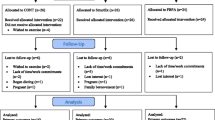Abstract
Investigation goals were to document discretionary time activities among older adults, determine whether time spent in discretionary activities varied by gender, and investigate whether participation in a prescribed physical activity (PA) intervention increased the time that older adults spend in discretionary time physical activities that were not specifically prescribed by interventions. Longitudinal data were drawn from 2 published studies of older adults. Study 1 compared 2 PA interventions in healthy older men and women (N = 103, M = 70.2 years), and Study 2 compared a PA intervention with a nutrition intervention in healthy older women (N = 93, M = 63.1 years). Participants in both studies completed similar assessments of their discretionary time activities using the Community Healthy Activities Model Program for Seniors questionnaire. Across both studies, at baseline, over 95% of participants reported talking on the telephone and reading as frequent sedentary discretionary time activities; over 80% reported visiting with friends and watching television or listening to the radio. Women engaged in significantly greater hours of social activities and household maintenance activities than did men (p < .05). From baseline to 12- month posttest, social, recreational, and household activities remained stable by gender and across time after participating in a PA intervention. Despite previously documented 2- to 3- hr increases in physical activities occurring in response to the study interventions, increases did not generalize for most participants to activities not prescribed by the intervention. Older adults are participating in numerous sedentary social and recreational activities that appear to remain stable across time and in the face of PA intervention prescriptions.
Similar content being viewed by others
References
Owen N, Leslie E, Salmon J, Fotheringham MJ: Environmental determinants of physical activity and sedentary behavior.Exercise Sport Sciences Reviews. 2000,28:153–158.
U.S. Department of Health and Human Services:Physical Activity and Health: A Report of the Surgeon General. Atlanta, GA: U.S. Department of Health and Human Services, Centers for Disease Control and Prevention, 1996
Crawford DA, Jeffery RW, French S: Television viewing, physical inactivity and obesity.International Journal of Obesity Related Metabolic Disorders. 1999,23:437–440.
Epstein LH, Paluch RA, Gordy CC, Dorn J: Decreasing sedentary behaviors in treating pediatric obesity.Archives of Pediatric Adolescent Medicine. 2000,154:220–226.
Salmon J, Bauman A, Crawford D, et al.: The association between television viewing and overweight among Australian adults participating in varying levels of leisure-time physical activity.International Journal of Obesity. 2000,24:600–606.
Saelens BE, Epstein LH: The rate of sedentary activities determines the reinforcing value of physical activity.Health Psychology. 1999,18:655–659.
Kamimoto LA, Easton AN, Maurice E, Husten CG, Macera CA: Surveillance for five health risks among older adults— United States, 1993–1997.Morbidity and Mortality Weekly Reports. 1999,48(SS08):89–130.
Cutler S, Hendricks J: Leisure and time use across the life course. In Binstock R, George L (eds),Handbook of Aging and Social Sciences (3rd ed.). New York: Academic, 1990, 169–285.
Herzog AR, Kahn RL, Morgan JN, Jackson JS, Antonucci TC: Age differences in productive activities.Journal of Gerontology: Social Sciences. 1989,44:S129-S138.
Pinto BM, Marcus BH, Clark MM: Promoting physical activity in women: The new challenges.American Journal of Preventive Medicine. 1996,12:395–400.
Zunft HJF, Friebe D, Seppelt B, et al.: Perceived benefits and barriers to physical activity in a nationally representative sample in the European Union.Public Health and Nutrition. 1999,2(Suppl.): 153–160.
Harvey AS: Time use studies for leisure analyses.Social Indicators Research. 1990,23:309–336.
Mead M:Male and Female: The Classic Study of the Sexes. New York: HarperTrade, 1949.
Freud S: On the sexual theories of children. In Strachey James (eds),The Standard Edition of the Complete Works of Sigmund Freud, 1953–1974. London: Hogarth Press and the Institute of Psychoanalysis, 1953, 207–226. (1908)
Skinner BF:Science and Human Behavior. New York: Macmillan, 1953.
Gilligan C: In a different voice: Women’s conceptions of self and of morality.Harvard Educational Review. 1977,47:481–517.
Herzog AR, Morgan JN: Age and gender differences in the value of productive activities.Research on Aging. 1992,14:169–198.
Chen AH, Sallis JF, Castro CM, et al.: A home-based behavioral intervention to promote walking in sedentary ethnic minority women: Project WALK.Women’s Health: Research on Gender, Behavior and Policy. 1998,4:19–39.
King AC, Pruitt LA, Phillips W, et al.: Comparative effects of two physical activity programs on measured and perceived physical functioning and other health-related quality of life outcomes in older adults.Journal of Gerontology: Medical Sciences. 2000,55(2):M74-M83.
King AC, Baumann K, O’Sullivan P, Wilcox S, Castro C: Effects of moderate-intensity exercise on physiological, behavioral, and emotional responses to family caregiving: A randomized controlled trial.Journal of Gerontology: Medical Sciences. 2002,57(1):M26-M36.
Bandura A:Social Foundations of Thought and Action: A Social Cognitive Theory. Englewood Cliffs, NJ: Prentice Hall, 1986.
Prochaska JO, DiClemente CC: Stages and processes of self-change of smoking: Toward an integrative model of change.Journal of Consulting and Clinical Psychology. 1983,51:390–395.
National Cancer Institute:5-A-Day for Better Health, Report No. CA-92-17. Bethesda, MD: Author, 1992.
Stewart AL, Mills KM, Sepsis PG, et al: Evaluation of CHAMPS, a physical activity promotion program for older adults.Annals of Behavioral Medicine. 1998,19:353–361.
Stewart AL, Mills KM, King AC, et al.: CHAMPS Physical Activity Questionnaire for Older Adults: Outcomes for interventions.Medicine Science Sports and Exercise. 2001,33:1126–1141.
Dill DB: The economy of muscular exercise.Physiological Reviews. 1936,16:263–291.
Ainsworth BE, Haskell WL, Leon AS, et al.: Compendium of physical activities: Classification of energy costs of human physical activities.Medicine Science Sports and Exercise. 1993,25:71–80.
Ainsworth BE, Haskell WL, Whitt MC, et al.: Compendium of physical activities: An update of activity codes and MET intensities.Medicine Science Sports and Exercise. 2000,32(Suppl):S498-S504.
Epstein LH, Roemmich JN: Reducing sedentary behavior: Role in modifying physical activity.Exercise and Sport Science Reviews. 2001,29:103–108.
Author information
Authors and Affiliations
Corresponding author
Additional information
This research supported in part by Grants AG 09991 and AG 12358 from the National Institute on aging and by institutional grant HL 58914 from the National Heart Lung Blood Institute.
About this article
Cite this article
Lee, R.E., King, A.C. Discretionary time among older adults: How do physical activity promotion interventions affect sedentary and active behaviors?. ann. behav. med. 25, 112–119 (2003). https://doi.org/10.1207/S15324796ABM2502_07
Published:
Issue Date:
DOI: https://doi.org/10.1207/S15324796ABM2502_07




